You can have the smartest people in the room, but if they don’t work well together, things fall apart. That’s not just opinion!
86% of business leaders blame workplace failures on poor teamwork and lack of collaboration.
Think about that.
Not skill gaps. Not a lack of resources. But the way people work together.
This post on teamwork and collaboration statistics is your shortcut to understanding why collaboration matters more than ever, and the numbers that prove it.
If you’re leading a team, joining one, or trying to fix an off-track one, what you’ll find here could shift how you think about working with others for good.
The stats you’ll see here come from verified and reputable sources. And if you want to fact-check or dig deeper, there’s a complete list of references waiting for you at the bottom of this post.
🔑 Key Teamwork & Collaboration Statistics:
1. The global collaboration tools market is projected to grow to $116,338.4 million by 2033, with a robust CAGR of 11.4% over the next decade.
(Future Market Insights)
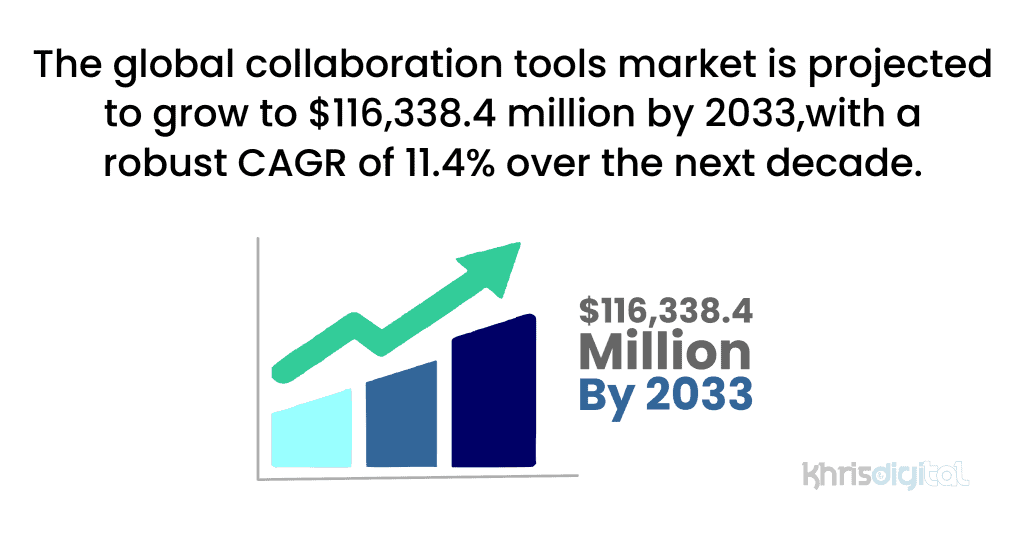
That kind of growth doesn’t happen unless something is essential.
An 11.4% annual growth rate signals more than market momentum. It shows a shift in how work gets done as remote teams, cross-functional projects, and faster communication are now business-critical.
Companies that ignore this trend risk falling behind not just in tech but also in teamwork.
2. About 75% of employers agree that teamwork and collaboration are essential in the workplace.
(Queens University of Charlotte)
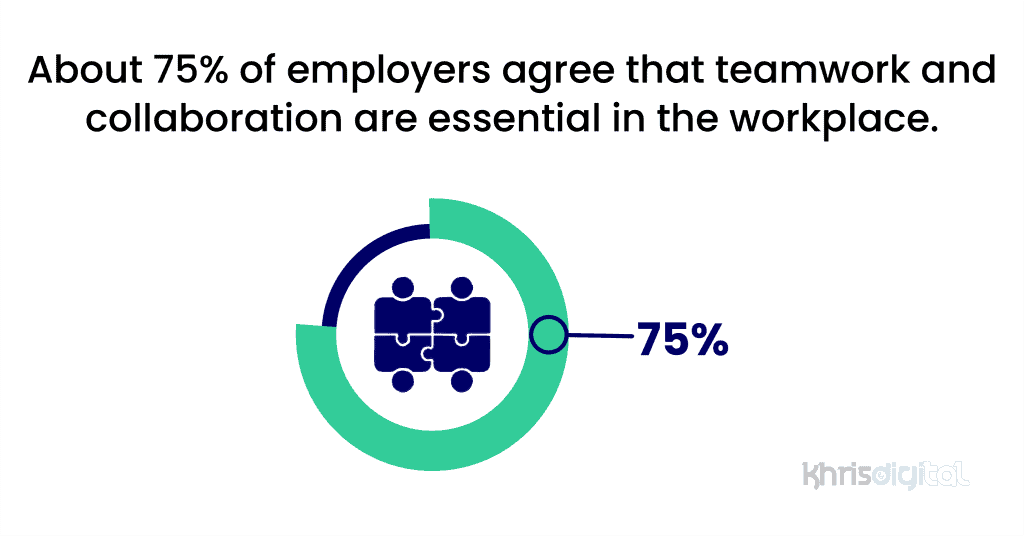
When three out of four employers call something essential, it’s no longer just a “soft skill.” Collaboration shapes how decisions are made, how problems get solved, and how fast teams move.
It’s tied directly to performance, innovation, and retention. In workplaces where teamwork is weak, ideas, execution, and morale slow down.
Employers are catching on. The real question is, are teams keeping up?
3. 86% of business leaders attribute workplace failures to a lack of collaborative teamwork.
(Salesforce)
When failure happens, most leaders aren’t blaming budgets or bad strategy, they’re pointing straight at how people work together.
Poor collaboration breaks trust, causes miscommunication, delays decisions, and kills momentum. It creates silos where problems get hidden and solutions stall. In a high-stakes environment, that’s a recipe for chaos.
Teams that don’t click, don’t win.
4. 73% of employees who engage in collaborative work report improved performance, while 60% say it sparks their innovation.
(Deloitte)

Collaboration pushes people to do better work. When employees collaborate, they’re not just more productive, they’re more creative.
That’s because bouncing ideas off others, solving problems together, and seeing different perspectives unlock new thinking. It fuels momentum. You get faster decisions, more innovative solutions, and more energy in the room.
5. 97% of employees and employers agree that lack of collaboration undermines workplace success.
(Fierce Inc)

When 97% of people agree on something, it’s not a debate, it’s a fact. Collaboration is the backbone of workplace success. Without it, misalignment creeps in, goals get missed, and frustration builds.
This kind of near-unanimous agreement is rare, and it should be a red flag for any organization not prioritizing collaboration right now.
6. Team collaboration can result in a 41% increase in customer satisfaction.
(Institute for Collaborative Working)
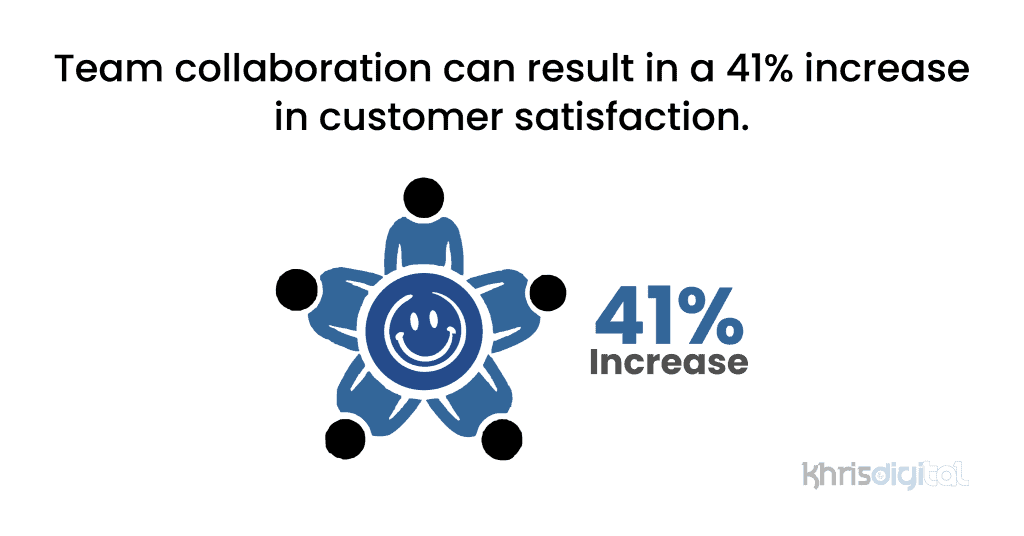
That 41% boost isn’t magic. It’s the result of internal alignment showing up externally. When departments share info and solve problems together, customers get what they need without the runaround.
The smoother the inside works, the happier the people on the outside. Simple as that.
7. 70% of employees believe better collaboration can have a positive impact on employee productivity and time savings.
(Alludo)
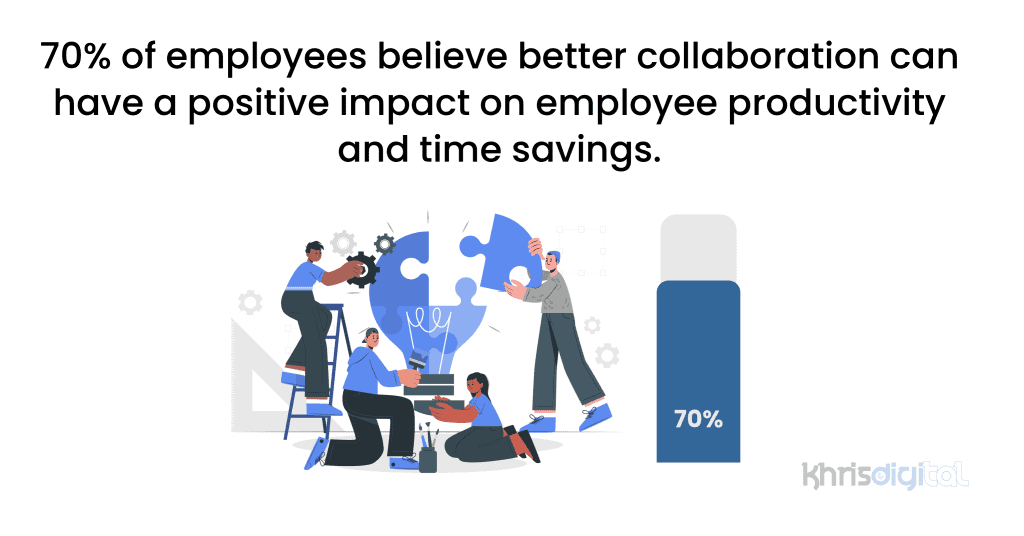
When collaboration works, work feels lighter. Fewer back-and-forths. Less duplicate effort. Faster decisions.
That’s what drives productivity and saves time. Most employees know this as they’ve seen how the right tools and teamwork can turn a chaotic day into a smooth one.
So when 70% say collaboration boosts output and saves hours, they’re speaking from real, lived experience.
8. Higher levels of team engagement can result in 21% higher profitability.
(Gallup)
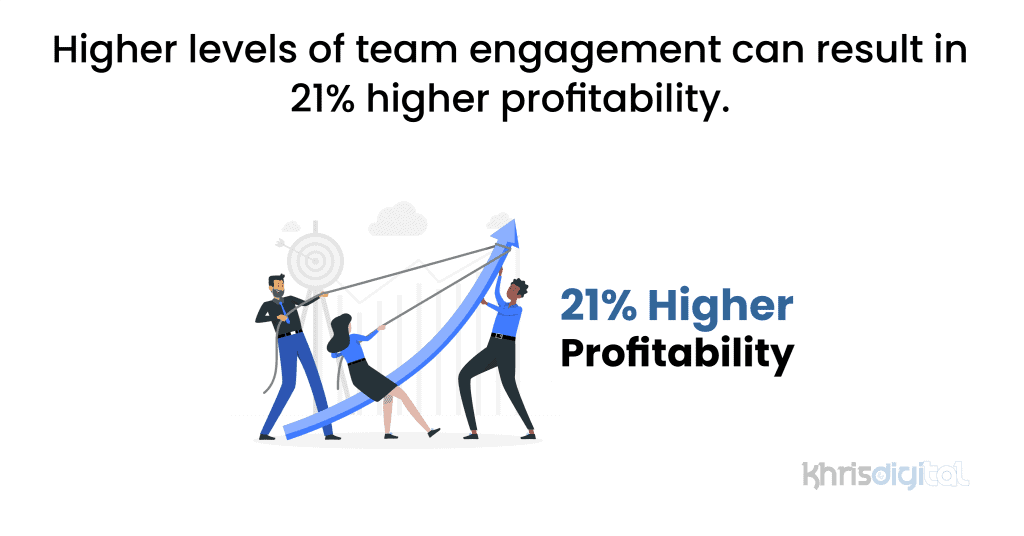
Engaged teams work smarter. They solve problems faster, support each other more, and care about outcomes.
That shows up in profit. When people are tuned in and connected, they catch mistakes early, spot opportunities quicker, and go the extra mile. Engagement is a money thing. And 21% more profit is proof that investing in teamwork pays off.
9. Companies that utilize teamwork and collaboration in the workplace are 5 times better than companies that don’t.
(Gitnux)
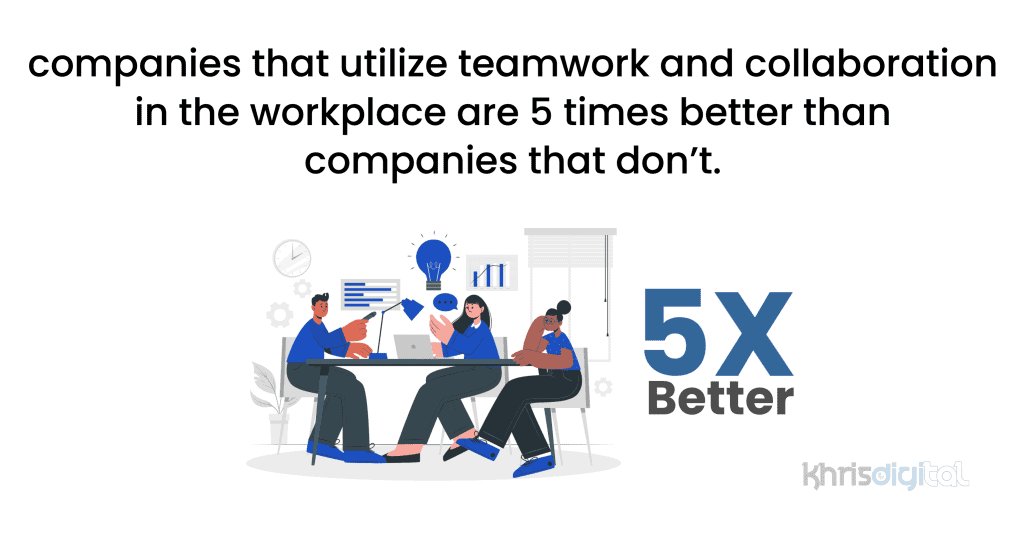
Being five times better means faster growth, stronger results, and more resilience when things get tough.
Teams that collaborate outperform because they adapt quickly, communicate clearly, and execute cleanly. If a company isn’t building collaboration into its culture, it’s setting itself up to lose.
10. Teamwork increases sales by 27%.
(Darwin Box)
When marketing, sales, and support work together, customers get a smoother experience, and deals close faster. Teamwork means better lead handoffs, smarter follow-ups, and fewer missed chances.
In high-performing teams, selling becomes a shared effort, and it shows in the numbers.
11. Studies reveal that 64% of employees waste at least three hours a week due to collaboration inefficiencies, with 20% losing up to six hours.
(Alludo)
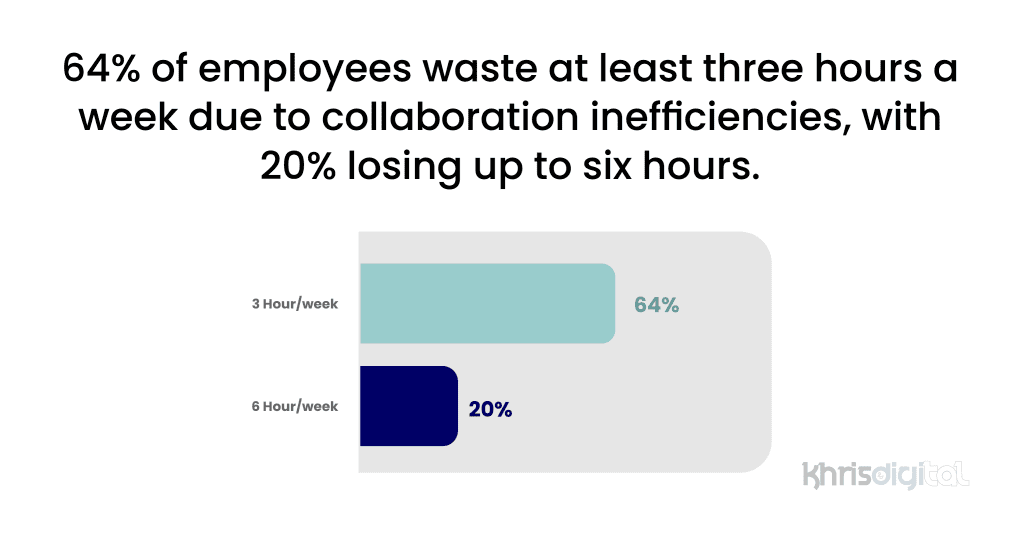
That’s nearly a full workday lost every week. The problem isn’t that people aren’t trying to collaborate; it’s that the systems and processes around it are broken.
Too many tools, unclear communication, endless back-and-forths. When collaboration isn’t intentional, it turns into chaos. And that chaos quietly drains time, energy, and focus from everyone on the team.
12. Up to 15% of employees’ total work time is wasted due to ineffective collaboration and communication.
(McKinsey)
That’s nearly a full day every week going down the drain. Poor collaboration doesn’t just slow things down; it compounds over time.
Missed messages, unclear roles, and duplicated work chip away at focus and momentum. Fixing this requires building clear, connected ways to work together.
13. High-performing teams exhibit five main traits: strong team members, collaborative problem-solving, solid relationships, good leadership, and supportive organizational culture.
(Harvard Business Review)
Great teams are shaped by the right people, the right mindset, and the right environment. It starts with individuals who bring skill and accountability, but it scales through how those individuals solve problems together.
Strong relationships and leadership create trust, while culture holds it all in place. Miss one piece, and performance drops. Get all five right, and teams run like machines.
14. Only 20% of executives consider their teams to be high-performing.
(Harvard Business Review)
Most leaders know what makes a great team, but very few feel like they actually have one. And that disconnect often comes from missing foundations such as unclear goals, weak collaboration, or broken trust.
15. 49% of surveyed U.S. workers say collaborating in the office is easier than at home, while only 15% say the opposite.
(Gensler)
Remote work isn’t the collaboration cure-all some hoped for. Nearly half of workers still feel more connected and effective when they’re physically together.
That doesn’t mean remote can’t work, it just means the tools and habits need to evolve. Without the hallway chats, body language, or quick clarifications, collaboration can feel clunky at home.
16. 37% of employees say “working with a great team” is their primary reason for staying.
(Visix)
People don’t just stay for perks or paychecks, they stay for the people. A strong team creates a sense of belonging, trust, and shared purpose. When that’s in place, work feels more meaningful and less draining.
17. About 30% of improvements in employee performance come from information gained through collaboration with other staff.
(Gitnux)
That’s nearly a third of growth tied directly to just talking to each other. When teams openly share what they know, everyone gets sharper. The right insight at the right time can change how someone works entirely.
It’s not constant training or tools that make the difference; sometimes it’s just a conversation.
18. Interestingly, 20% to 35% of all high-value collaborations are contributed by just 3% to 5% of employees.
(Harvard Business Review)
That’s a huge load carried by a tiny fraction of the team. These “go-to” collaborators are often the glue that holds projects together, answering questions, connecting the dots, and helping others succeed.
But it’s also a risk. If too much depends on too few, burnout creeps in, and the whole system weakens.
19. Employees report a 72% boost in productivity, 63% better customer service, and 60% higher confidence from effective communication and collaboration.
(Grammarly)
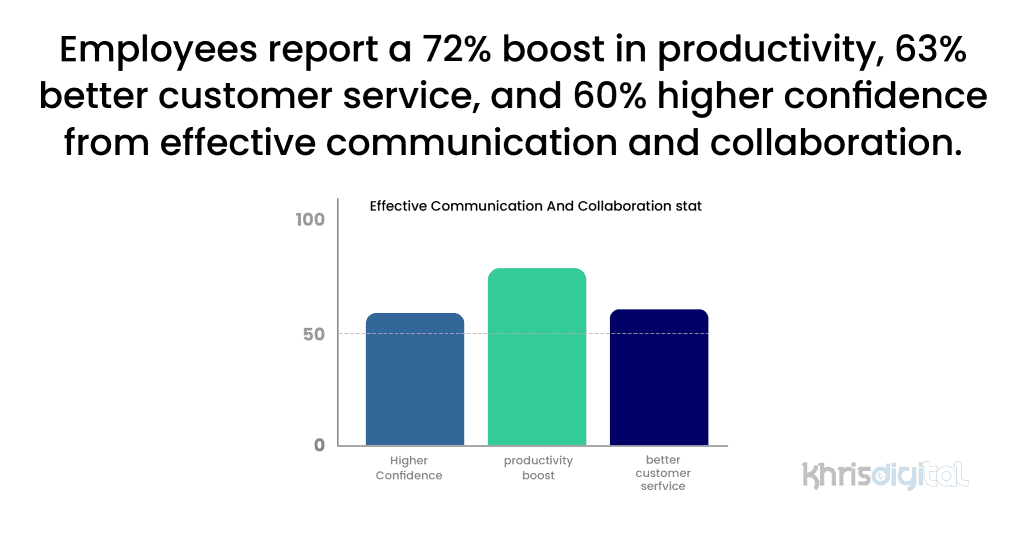
Productivity jumps, customers are happier, and employees feel more capable, all from simply working better together. It proves that communication and collaboration are force multipliers. When teams are aligned and talking clearly, everything improves.
20. 60% of workers report that collaboration reduces burnout by providing mutual support.
(Vorecol)
Burnout doesn’t just come from workload, it comes from isolation. When people feel alone in their tasks, stress builds fast. But when there’s a sense of “we’re in this together,” the load feels lighter.
Collaboration creates space for empathy, shared problem-solving, and emotional backup.
21. Collaboration enables 41% of employees to recognize their strengths and weaknesses, promoting personal growth and self-awareness.
(B2B Reviews)
Working with others holds up a mirror. You see what you’re great at, and where you need support. That kind of clarity doesn’t come from working in a silo. It comes from honest feedback, shared wins, and even a few stumbles together.
22. Happy employees are 13% more productive.
(University of Oxford)
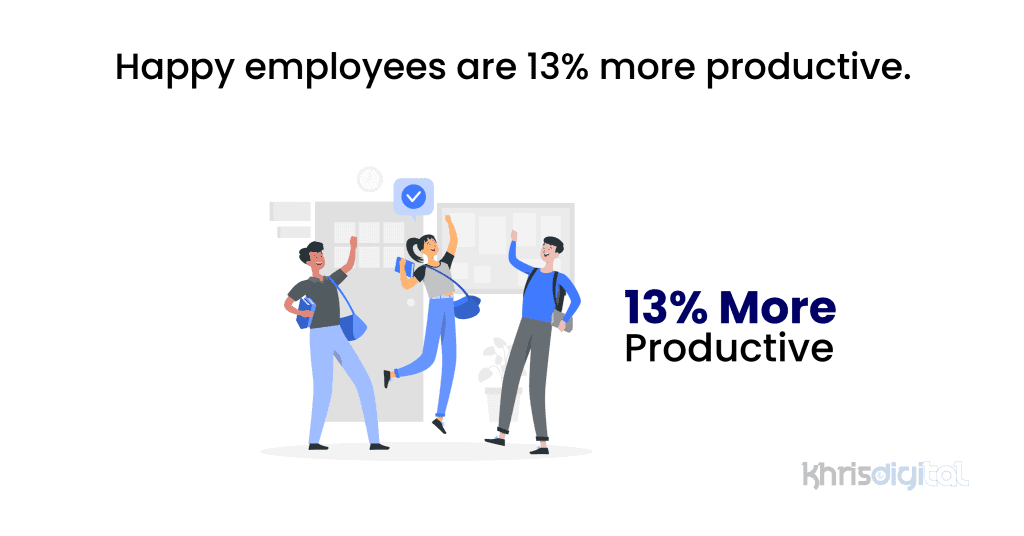
When people feel good at work, supported, connected, and part of something that works, they perform better.
Collaboration plays a huge role in that happiness. It builds trust, reduces stress, and gives people a sense of belonging. And that emotional lift? It shows up in the output. Because when teams feel good, they do good.
23. Effective teamwork can reduce absenteeism and enhance engagement by 60%.
(Sage Journals)
People show up when they actually want to be there. Strong teamwork creates that kind of environment, one where employees feel connected, valued, and involved.
That drives engagement. And when people are engaged, they’re less likely to call out, check out, or burn out. The result? More presence, more energy, more momentum.
24. Teams of 3 to 5 members perform best when solving complex problems, as they share and validate ideas efficiently.
(PubMed)
Smaller teams hit the sweet spot. With 3 to 5 people, there’s enough diversity of thought to spark innovation, but not so many voices that things get bogged down.
Ideas get shared, challenged, and refined quickly. Everyone stays engaged.
25. Two-person teams completed tasks like assembly faster than larger teams.
(PubMed)
Sometimes, more hands don’t make lighter work, they make slower work.
In task-focused settings like assembly, two-person teams often move faster because there’s less coordination needed, fewer voices to manage, and more clarity. It’s lean, it’s focused, and it works.
26. Diverse teams achieve 12% higher performance, as different perspectives fuel innovation.
(Gartner)
When teams bring different backgrounds, experiences, and ways of thinking to the table, better ideas follow. Teams that view challenges from multiple angles build better solutions. Innovation thrives when everyone doesn’t think the same.
27. Teams aligned with a shared vision are 1.9 times more likely to surpass financial goals.
(McKinsey)
When everyone knows where the team is headed and why it matters, work becomes more focused and results follow. Alignment cuts through noise, reduces friction, and keeps energy moving in the same direction.
28. 41% of employees find it more challenging to collaborate across departments than within their own teams.
(Gallup)
Internal teamwork is hard enough, but cross-team collaboration is even harder. Different priorities, communication styles, and systems can turn simple tasks into drawn-out headaches.
This stat shows the hidden friction that often slows down even the best organizations. Solving it takes more than tools, clear alignment, shared goals, and leadership that actively breaks down silos.
29. Over 1,500 companies have incorporated human intelligence and AI collaboration in their projects
(Harvard Business Review)
Forward-thinking companies are blending AI into their teams, not to replace people, but to enhance how they work.
Whether it’s speeding up research, streamlining workflows, or surfacing insights, AI is becoming a teammate. The real power lies in the combo: human creativity plus machine efficiency.
30. 94% of companies say they want to adopt a cognitive collaboration (Human intelligence + AI) solution for their workers
The future of teamwork is hybrid, not just in location, but in intelligence. Nearly all companies now see the value of blending human insight with AI-powered speed and precision.
Cognitive collaboration means giving teams more innovative tools, better data, and faster feedback.
31. 91.1% of employees say they want to work for organizations that cultivate honest communication and collaboration.
(Team Stage)
At the end of the day, people want to belong. When communication is honest and collaboration is real, work feels human. It builds trust, safety, and pride.
32. Effective team collaboration platforms improve productivity by 10%.
(Forrester)
Sometimes, the difference between chaos and clarity is the right platform. When teams have one place to share, plan, and move together, things speed up. Tasks don’t fall through the cracks. Conversations don’t get lost.
33. Effective collaboration platforms allow employees to save about 5–10% of their work time and reduce work stress.
(Forrester)
When teams have clear, connected platforms, they waste less time hunting for info or chasing updates. That 5–10% time savings adds up fast. But maybe more importantly, it lowers stress. Less chaos. Fewer misfires. More breathing room.
34. Effective communication and collaboration generate 4.5× higher talent retention.
(Team Stage)
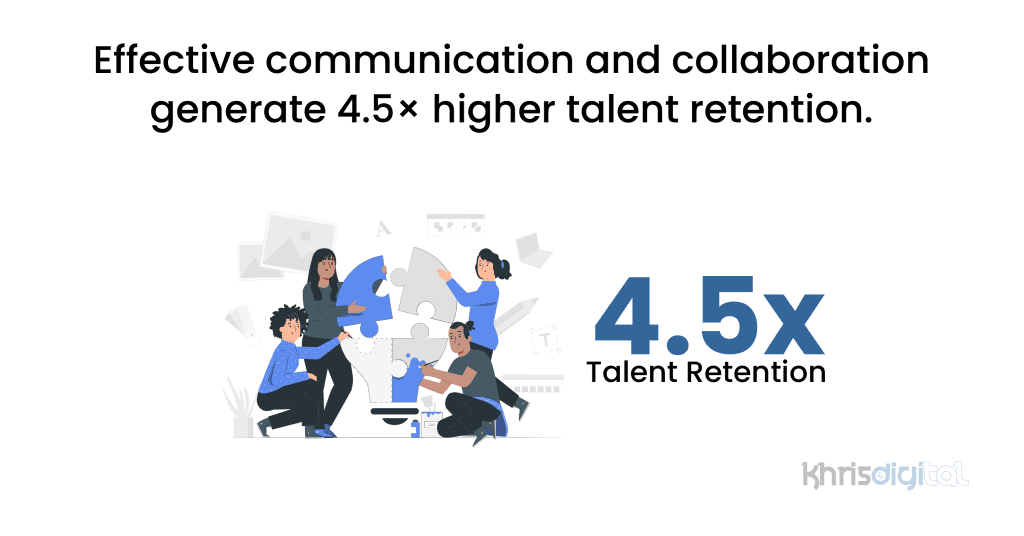
When teams communicate clearly and work well together, employees stick around. They feel heard, supported, and connected to something that works. Strong collaboration builds trust, and trust builds loyalty.
35. 82% of leaders and 72% of employees report that a lack of time between meetings makes it challenging to complete essential tasks.
(Zoom)
Everyone’s talking, but no one has time to do. Packed calendars and back-to-back meetings are killing focus.
When there’s no breathing room, real work gets squeezed out. It’s a symptom of poor collaboration habits, not knowing when to meet, how long to meet, or if a meeting’s even needed. Better teamwork is about smarter, less disruptive ways to connect.
36. 41% of employees would like to see a change in their company culture or engagement.
(Gallup)
Nearly half the workforce is quietly hoping for something better. A culture where collaboration is weak or engagement is low wears people down. They might not speak up, but they’re thinking about leaving, or checking out while staying.
Shifting this starts with how teams connect, communicate, and support each other. Change culture, and everything else follows.
37. Only 21% of leaders report actively recruiting and promoting from diverse talent pools.
(DDI)
Most leaders say they value diversity, but far fewer are actually doing the work to build it. Without active recruitment and promotion from underrepresented groups, collaboration suffers.
You miss out on different voices, ideas, and lived experiences — the exact things that drive innovation and team strength.
38. 49% of in-office workers observed that staying motivated and connected with their team were the biggest challenges in the transition from remote work to an in-office work setting.
(HubSpot)
Coming back to the office wasn’t the fix many hoped for. Nearly half of employees felt the shift actually made it harder to stay motivated and feel connected.
Without strong team dynamics and intentional collaboration, location doesn’t solve much. The challenge now? Rebuilding team trust, energy, and purpose, wherever people are sitting.
39. 40% of remote workers miss spontaneous, in-person connections with their colleagues.
(HubSpot)
The little moments matter, hallway chats, coffee breaks, that quick joke before a meeting. These unscheduled interactions build trust, spark ideas, and remind people they’re part of something bigger.
Great collaboration isn’t all structured, sometimes, it starts with a casual “Hey, got a sec?”
40. 41% of enterprise workers have either left their jobs or would consider leaving due to poor workplace collaboration.
(Alludo)
Bad collaboration is a dealbreaker. When teams can’t communicate, align, or support one another, frustration builds quickly. People don’t want to waste their time fighting systems, chasing updates, or working in silos. Eventually, they check out or walk out.
41. 53% of people have suffered from burnout, stress, and fatigue due to communication issues in their business.
(Project.co)
Confusion, missed expectations, and constant misalignment wear people down. It creates tension, anxiety, and a sense of being stuck. Great collaboration protects your people, and that’s what really matters.
42. More than a third (36%) of people have dealt with missing or lost files at work due to communication problems.
(Project.co)
It sounds small until it happens to you. That one file that went to the wrong person, got buried in an email thread, or never got shared at all? It slows down progress, kills momentum, and erodes trust.
When communication breaks down, even basic tasks turn into roadblocks.
43. 65% of people feel they regularly waste time in meetings.
(Project.co)
Let’s be real, most meetings could’ve been an email.
When nearly two-thirds of people feel their time is wasted, it’s not just frustrating, it’s expensive. Meetings with no clear goal, too many people, or no decisions made drain energy fast.
44. Companies are losing business due to poor communication — 66% of clients have switched to competitors for this reason.
(Project.co)
Clients don’t wait around while you fumble with communication. Two-thirds have already walked away because they weren’t being heard, helped, or handled well.
Internally poor coammunication leaks externally, and customers feel it. The result? They go where they feel understood.
45. Over half of U.S. employees have limited or no insight into other teams’ objectives, creating fragmented work environments.
(McKinsey)
When teams don’t know what the other is working toward, alignment disappears. People double up, miss handoffs, or push in opposite directions, not out of laziness, but out of disconnect.
This kind of fragmentation drains energy, delays outcomes, and fosters frustration.
46. Only 5.9% of companies communicate goals daily.
(Everyone Social)
That means over 94% of teams are flying blind, or at least a little foggy. When goals aren’t reinforced regularly, priorities blur and focus drifts. The best teams don’t just set goals and forget them.
They talk about them. Revisit them. Keep them front and center. Because clarity, when repeated often, creates momentum.
47. 70% of hybrid employees adapt their meeting structures to ensure inclusivity and equal participation, compared to only 49% of on-site employees.
Hybrid teams are learning fast: if you want collaboration to work, you have to design it with intention.
That means rethinking meetings — who speaks, who’s heard, and how everyone can contribute. The fact that hybrid teams are more likely to build inclusive meeting habits shows how necessity can drive innovation.
48. In companies where employees are empowered to make delegated decisions, the likelihood of success increases by 3.9 times.
(McKinsey)
When teams are trusted to act, not just execute, everything moves faster. Empowered employees don’t wait around for approvals; they take ownership, solve problems, and drive progress.
Delegated decision-making isn’t risky when teams are aligned and communication is strong. It’s what separates agile, high-impact teams from slow, approval-choked ones.
49. 96% of decision-makers and 95% of employees identify communication as crucial for workplace success.
(Microsoft)
Everyone, from the C-suite to the front lines, agrees that if communication breaks down, everything else suffers. Projects stall. Morale dips. Trust fades. Clear, open, and consistent communication is the common thread that ties all successful teams together.
50. Miscommunication causes 28% of missed deadlines
(Expert Market)
Whether it’s unclear instructions, unchecked assumptions, or missed updates, the cost of miscommunication is real. It slows teams down, frustrates clients, and wrecks momentum.
The fix? Better systems, more precise language, and a culture that encourages asking questions rather than punishing them.
51. Email remains the primary communication tool for 88% of remote workers.
(Coso Cloud)
Even with all the new tools out there, email still dominates. But that doesn’t mean it’s perfect. Overuse can slow things down, bury important info, and lead to miscommunication.
If email is your primary channel, it’s critical to use it intentionally with clear subject lines, focused messages, and consistent follow-ups. Otherwise, things get lost in the flood.
52. 40% of professionals prefer daily standups to stay connected remotely, while 22% favor informal check-ins and 20% value periodic feedback.
(Proof Hub)
There’s no one-size-fits-all when it comes to remote connection, but structure helps. Daily standups give teams rhythm and clarity. Informal check-ins keep things human. Periodic feedback drives growth.
The takeaway? Teams thrive when there’s a mix of predictability and personal touch.
53. Real-time feedback through AI systems has been linked to a 40% improvement in project turnaround times.
(Reworked)
Real-time AI feedback helps teams adjust instantly, rather than waiting for weekly reviews or post-mortems. It cuts the lag, catches problems early, and keeps momentum high.
That 40% improvement in turnaround time proves how powerful it is when guidance and timing align.
54. 71% of leaders see a positive impact on employee happiness and satisfaction due to hybrid and remote work options.
(Zoom)
Flexibility is a proven driver of well-being. When employees have the freedom to choose how and where they work, satisfaction rises.
So does loyalty, focus, and morale. Leaders are finally seeing what employees have known all along: trust breeds happiness, and happiness boosts performance.
55. 36% of employees feel remote work hurts workplace collaboration.
(FlexJobs)
Remote work offers freedom, but for over a third of employees, it also creates distance. Collaboration can feel slower, less personal, or harder to spark naturally. Without face-to-face moments, trust and alignment take more work.
56. 28% of workers feel they have a higher workload when working remotely than when working in the office.
(FlexJobs)
Remote work was supposed to make life easier, but for over a quarter of employees, it’s done the opposite. Without clear boundaries, the workday stretches. Expectations blur. Notifications never stop. What feels like flexibility can quickly become overload.
57. 80% of employees believe remote work collaboration is either better than or just as good as in-person.
(Corel)
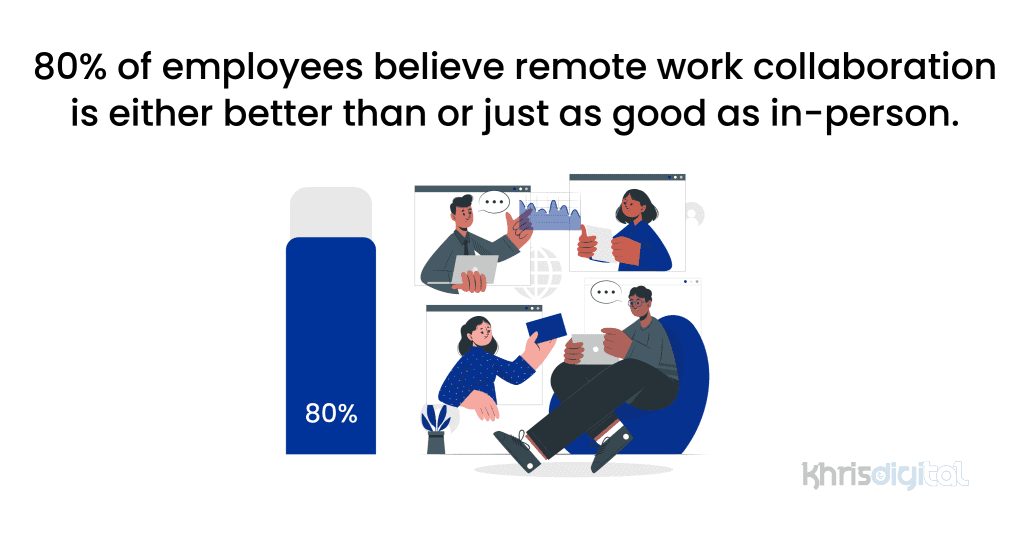
Despite the challenges, most employees are saying loud and clear that remote collaboration works.
For many, it’s more focused, less stressful, and just as effective as being in the office, sometimes even more. With the right tools, trust, and habits, great collaboration can happen from anywhere.
58. 28% of marketers find collaboration boosts visibility.
(HubSpot)
For marketers, working closely with others increases exposure across departments, highlights strengths, and builds recognition beyond their immediate team.
It’s about more than sharing the workload, it’s sharing credit, ideas, and momentum. And when your work is visible, your impact grows.
59. Among emerging leaders aged 30–35, over 50% feel that collaboration will become even more essential for their success.
(Proof Hub)
These rising leaders understand that success is built on connection, shared thinking, and strong team dynamics. As work becomes more complex and fast-paced, collaboration is a survival tool.
60. Unengaged and actively disengaged employees contribute to an estimated $1.9 trillion in lost productivity across the U.S. annually.
(GallUp)
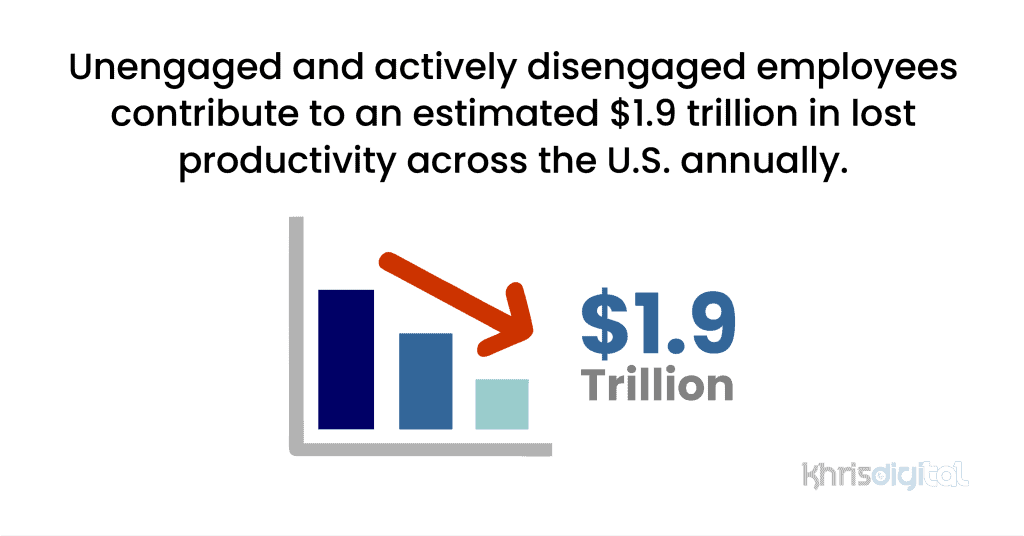
That’s a massive, national cost tied directly to poor engagement.
And at the heart of disengagement? Broken communication, weak collaboration, and disconnected teams. When people don’t feel involved, supported, or heard, they check out even while still on the clock.
61. Managers account for 70% of the variance in employee engagement.
(GallUp)
The way leaders communicate, set expectations, support their teams, and foster collaboration directly shapes how engaged people feel.
Excellent collaboration starts from the top. And when managers get it right, everything else follows: morale, productivity, retention, and results.
62. Remote employees experiencing isolation report a 21% drop in productivity.
(GallUp)
Productivity depends on time management and connection. When remote workers feel isolated, focus dips, motivation stalls, and output suffers.
Inclusive, connected team environments are a performance necessity. Without that sense of belonging, even the most talented people start to fade.
63. 75% of leaders whose teams use AI say their teams collaborate better.
(Zoom)
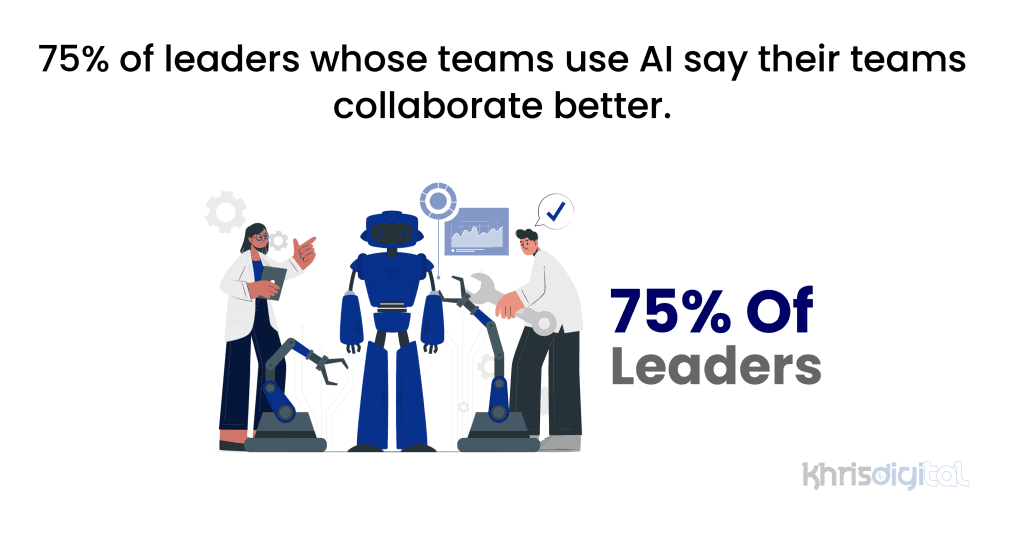
For three out of four leaders, introducing AI into the workflow has actually made collaboration smoother.
From faster insights to smarter decision-making, AI clears the clutter so people can focus on what matters: communicating, problem-solving, and moving together.
64. Office workers spend 42% of their time daily on average, collaborating with others.
(Gensler)
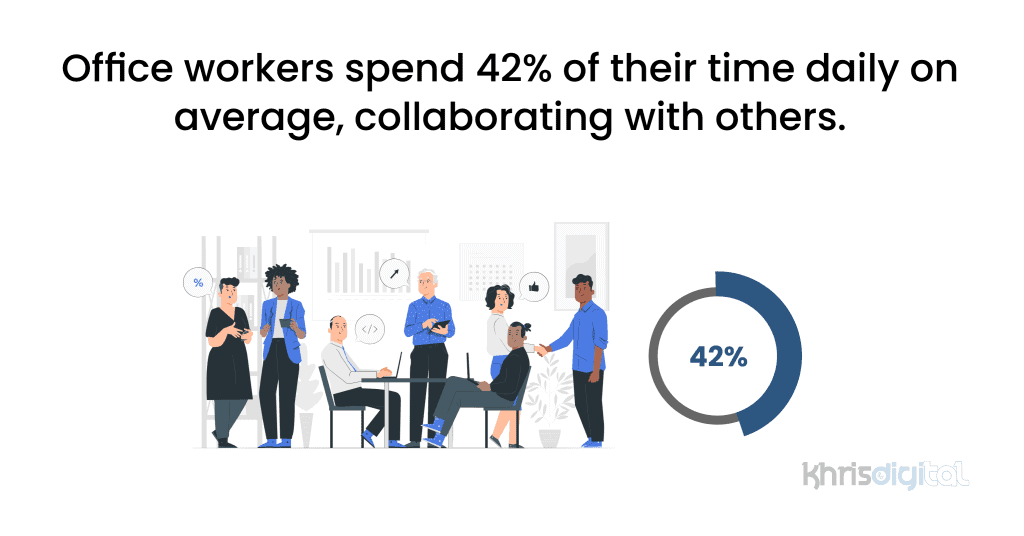
Almost half the workday is spent talking, planning, syncing, and aligning. That makes collaboration not just a part of the job, but the job.
If it’s inefficient, unclear, or inconsistent, nearly half the work suffers. But when collaboration runs smoothly? Everything else gets a lift.
65. Only 24% of company leaders feel their organization is very ready to develop the “right” workplace model.
(Deloitte)
Most leaders know the future of work is changing, but few feel truly prepared to lead that change.
The “right” model is built on clarity, collaboration, trust, and adaptability. And if leaders aren’t ready to rethink how their teams communicate and work together, they’ll struggle to keep up.
66. 39% of surveyed employees feel their organization doesn’t collaborate enough.
(Runn)
That’s nearly 4 in 10 employees who feel disconnected, unheard, or siloed, even when working side by side. It’s a red flag that many teams think they’re collaborating, but the reality doesn’t match.
67. Employees at companies with high trust report 76% more engagement and 40% less burnout.
(MIT Sloan Management Review)
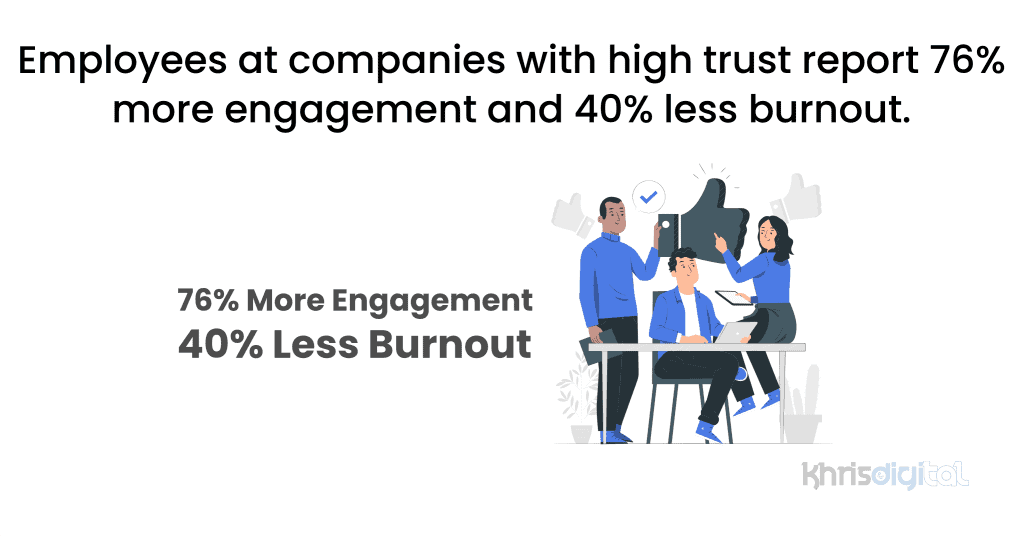
When employees feel trusted and safe, they show up fully. They take initiative, support one another, and bring energy to the table. And burnout? It drops because people aren’t spending their energy second-guessing, over-explaining, or protecting themselves.
High-trust environments create space for honest collaboration, faster progress, and better well-being.
68. Collaboration can increase individual loyalty to an organization by 33%.
(Mural)
People don’t just stay for paychecks, they also stay for purpose, connection, and teamwork that actually works. When employees feel part of a team that communicates clearly, solves problems together, and supports each other, loyalty grows.
69. 84% of marketers experience frustration and inefficiency from excessive meetings, redundant feedback loops, and unclear roles.
(Gartner)
When everyone’s talking but no one’s aligned, things fall apart fast. Endless meetings, vague feedback, and fuzzy responsibilities drain energy and delay results.
For marketers, whose work depends on speed, clarity, and creativity, poor collaboration kills momentum.
70. Teams with connected employees see productivity increase by 20–25%.
(McKinsey)
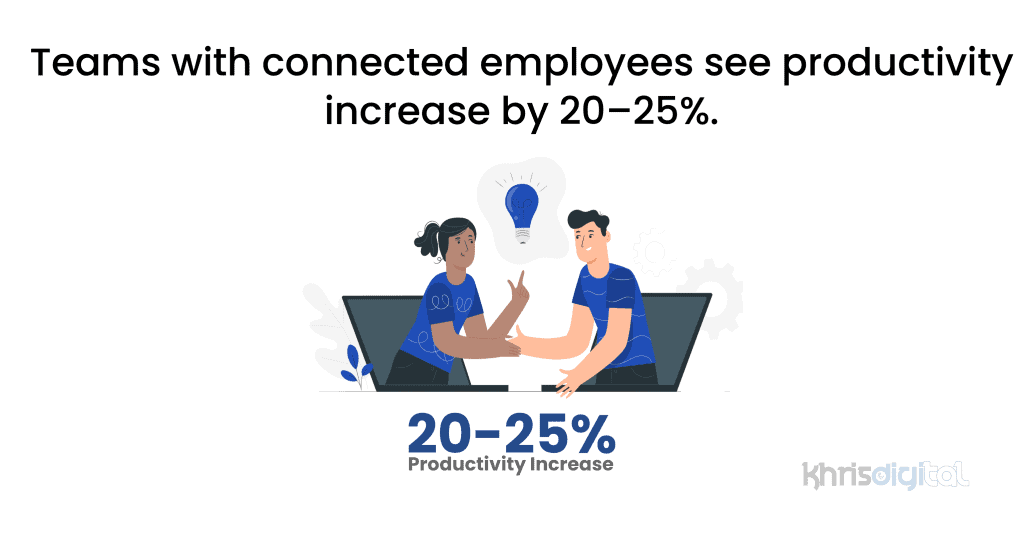
When people feel connected, they perform better. Connection fuels clarity, and clarity drives speed. Whether in person, hybrid, or remote, the best teams work like a unit because they feel like one.
71. A company with about 100 employees can lose an average of $420,000 annually due to poor communication.
(Society for Human Resources Management)
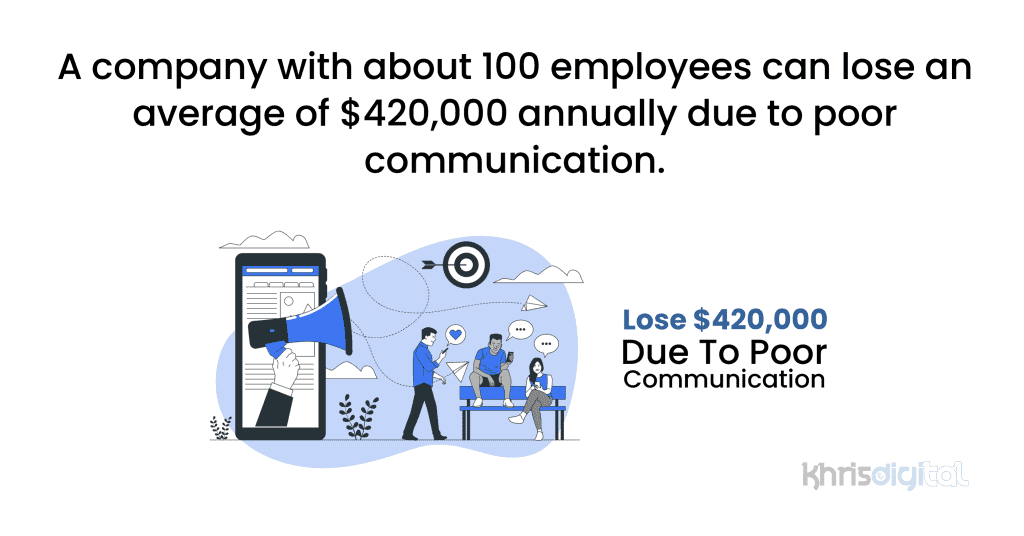
That’s nearly half a million dollars walking out the door, not from bad products or lost clients, but from simple miscommunication.
Missed messages, unclear goals, and avoidable mistakes add up fast. For small to mid-sized companies, this kind of waste can be the difference between growth and struggle.
72. A company with 100,000 employees can lose an average of $62.4 million per year due to poor communication.
(Society for Human Resources Management)
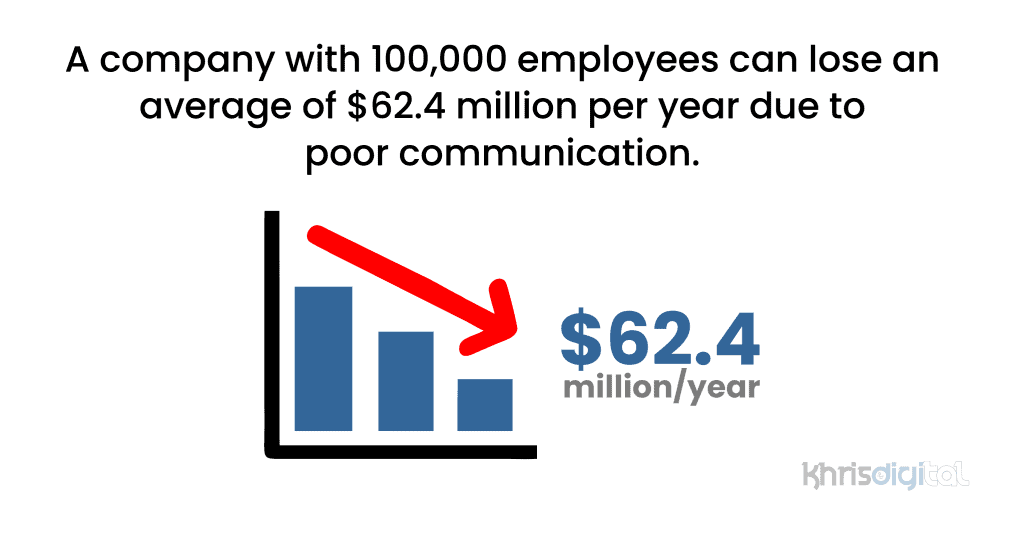
At scale, every missed message, misaligned project, or confusing handoff snowballs. And the price tag? Staggering. Poor communication slows teams down and silently bleeds millions. For large companies, fixing this is a financial imperative.
73. CMOs can reduce collaboration drag by as much as 23% through targeted skill-building initiatives and strategic talent investment.
(Gartner)
Collaboration drag isn’t just about bad tools, it’s about missing skills and mismatched talent. CMOs who invest in clear training, thoughtful hiring, and role alignment can cut down nearly a quarter of the friction that slows teams down.
74. Companies implementing agile engagement programs, like four or more check-ins per year, grew up to 10× faster within 12 months.
(ELE Insight)
When companies check in regularly, course-correct often, and stay connected to their people, growth accelerates.
Traditional annual reviews can’t keep up. But real-time feedback, regular alignment, and ongoing dialogue? That’s what builds trust, momentum, and serious growth.
75. 81% of those who enjoy a positive workplace experience cite choice in the workspace as essential,
(Gensler)
Where you work, how you work, and with whom you collaborate matter. When employees have a say in their environment, engagement rises. So does trust. The workplace experience improves not by imposing structure, but by designing for freedom, focus, and flow.
76. Approximately three-quarters of office workers report having control over where to work within the office.
(Gensler)
Choice fuels ownership. When employees can choose where they work inside the office — quiet zone, meeting room, lounge — they’re more likely to feel in control, respected, and productive.
The ability to move based on task, energy, or collaboration needs turns the office into a tool rather than just a location.
77. 41% of employees felt more productive working remotely than in an office setting.
(McKinsey)
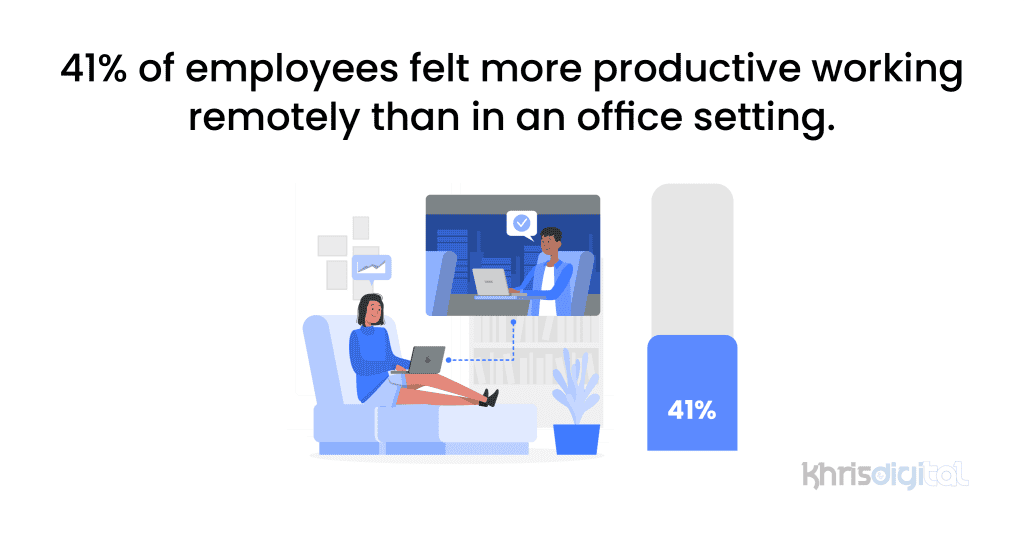
The old assumption that people work best under office lights is fading. Fewer distractions, more autonomy, and the ability to shape their own flow have made remote work a productivity booster, not a barrier.
78. The pandemic led to a 16% increase in collaboration with immediate teammates and a 21% decrease with peripheral colleagues.
(Humanyze)
While remote work brought core teams closer, it also shrank the broader network. Spontaneous chats and cross-team interactions fell off, and with them, opportunities for innovation, mentorship, and new ideas.
79. 75% of employees feel remote/hybrid tools need improvement, and 72% believe their organization should invest in better tech for flexible work.
(Zoom)
Most employees know that clunky tools, scattered systems, and outdated processes are holding them back. Flexibility only works when the infrastructure supports it.
Teams want tech that matches the way they actually work — seamless, fast, and collaborative. Organizations that don’t invest in better tools will fall behind.
80. 76% of the global workforce now relies on video conferencing and other collaboration tools.
(Microsoft)

Collaboration has officially gone digital. Video calls, shared docs, and team chats are essentials. For most of the world, these tools are the workplace.
Any company still resisting this change is invisible. The future of teamwork is powered by tech, and it’s already here.
81. Usage of online collaboration tools has surged by 44% since 2019, spurred by remote work demands.
(Gartner)
In just a few years, how we work has changed fast. Teams had to find ways to stay connected, keep moving, and remain aligned without being in the same room.
The demand for smarter, faster, more intuitive tools is growing because collaboration is how work happens.
82. 46% of employees believe that colleagues with their video on appear more engaged and involved in meetings.
(Forbes India)
It doesn’t mean cameras need to be on 24/7, but it does show how simple actions shape team dynamics. In a virtual world, perception matters. A little face time can go a long way in building trust and connection.
83. Nearly 40% of Gen Z and millennial workers report that workplace culture has “a great deal” of impact on their intent to stay at their current job.
(Ey.com)
Culture is no longer a side dish. It’s the main course. And at the heart of culture? Communication, collaboration, and how people treat one another.
If the environment feels toxic, cold, or disconnected, the next generation won’t wait around, they’ll find somewhere better.
84. 40% of employees wish companies would enforce stricter rules around the use of online collaboration tools.
(ZD Net)
More tools don’t mean more productivity; without boundaries, it becomes noise. Nearly half of employees are asking for structure: clearer guidelines, less tool-switching, and better norms around how (and when) to use platforms.
When collaboration tools are used intentionally, teams move faster, communicate better, and waste less time.
85. 85% of hybrid employees cited collaboration tools as one of the most critical areas of focus.
(Harvard Business Review)
Hybrid work lives or dies by how well people stay connected. For the vast majority of hybrid employees, the lack of solid collaboration tools communication, progress, and morale slows down slow down.
86. 59% of surveyed employees believe that their collaboration tools do not align with how their teams work.
(Harvard Business Review)
It’s not enough to have tools; they have to work the way your team actually does.
Over half of employees say the platforms they use aren’t built for their actual workflows. That means more friction, more wasted time, and more frustration.
The best tools are behavior-aware. When there’s alignment between tech and team habits, collaboration becomes seamless instead of stressful.
87. People who collaborate on the job and have access to digital collaboration tools are up to 17% more satisfied with their job and workplace culture.
(Harvard Business Review)
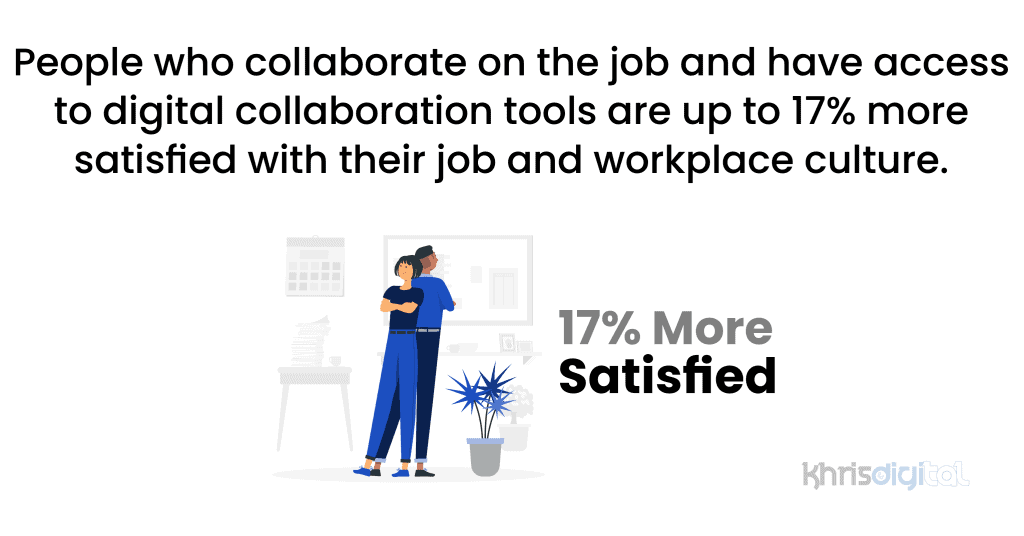
When teams are connected and have the tools they need actually to work together, satisfaction rises. And when that happens, loyalty follows. Culture isn’t built by posters, it’s built by how people collaborate every day.
88. Online collaboration tools and digital workplaces facilitate increased productivity by up to 30%.
(McKinsey)
When teams are equipped with the right digital systems, they move faster, communicate clearly, and get more done with less friction.
89. 83% of employees rely on using technology for collaboration.
(Alfresco)
Collaboration today runs on Wi-Fi. Whether it’s messaging apps, video calls, or shared docs, tech is how most teams stay connected.
The question isn’t whether to invest in them, it’s how to make them work better for your people.
90. Employees using more than 10 apps report communication issues at a higher rate (54%) than those using fewer than five apps (34%).
(Zoom)
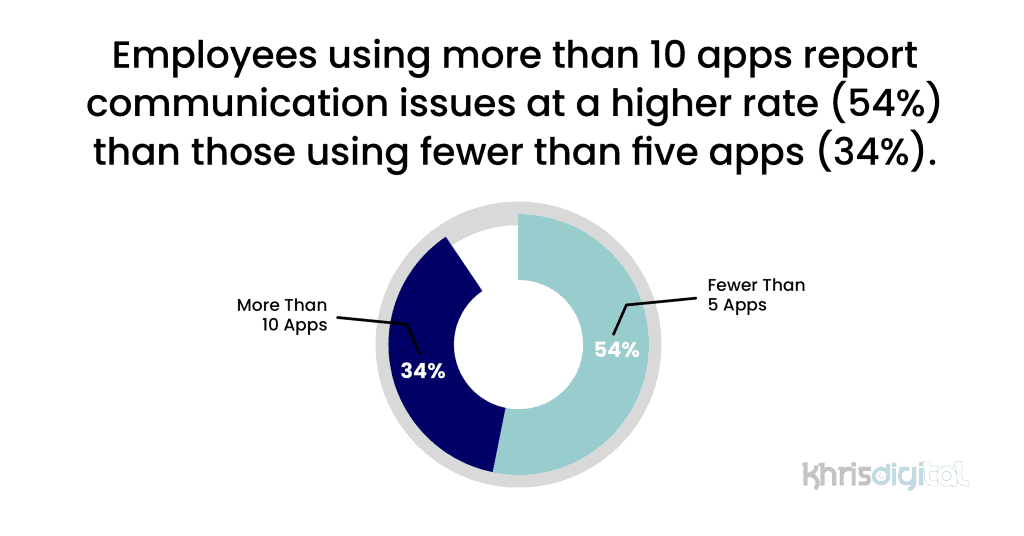
Tool overload is real. When teams juggle too many platforms, messages scatter, priorities blur, and collaboration breaks down. More apps often mean more confusion, not more clarity.
The fewer tools you need to keep everything moving, the stronger your team’s communication will be.
91. Leaders using AI report strong results: 85% complete tasks faster, 84% are more productive, and 81% deliver higher quality work.
(Zoom)
AI is a high-performance partner. For leaders, it’s about speeding up decision-making, sharpening focus, and raising the bar on output. This stat shows that the right AI tools can boost speed, productivity, and quality at the same time.
92. 65% of professionals say the ability to instant message and video conference on the same platform is important.
(Rocket.Chat)
Switching between tools kills flow. For most professionals, having chat and video in one place is essential. It keeps communication fluid, decisions fast, and teams connected without the lag.
93. 83% of workers say they have a good understanding of project status when using a project management tool to communicate.
(Project.co)
When communication happens inside the workflow, clarity follows. Project management tools track tasks, centralize updates, feedback, and context. For 83% of workers, that means fewer surprises and stronger alignment.
94. Only 32% of employees have received guidance on how to use unified communication and collaboration tools.
(HubSpot)
Tools are only as good as the people using them, and most employees figure it out on their own. Without training, even the best platforms lead to confusion, missed messages, and wasted time.
95. 26% of employees use an online chat tool to communicate with their colleagues.
(Project.co)
Chat is quietly becoming the backbone of daily teamwork. Quick questions, status updates, and casual check-ins all happen faster in chat than email.
While only a quarter of employees are using it now, that number is growing as teams move toward real-time, more human communication.
96. Only 7% of professionals communicate via phone.
(Project.co)
The phone used to be the go-to. Now? It’s barely used. With chat, email, video, and project tools dominating, only a small fraction of professionals still rely on voice calls.
Today’s teams want communication that’s efficient, flexible, and documented, and the traditional phone call can’t keep up.
97. Up to 80% of businesses use social collaboration tools to enhance business processes.
(McKinsey)
Social collaboration tools bring the speed of conversation into structured workflows, helping teams make faster decisions, share knowledge, and break down silos.
Collaboration has officially moved from the breakroom to the backbone of how work gets done.
98. Up to 90% of surveyed organizations use collaboration software for internal communication.
(ZDNet)
Email alone doesn’t cut it anymore. Most companies now rely on collaboration software, not just for convenience, but for speed, clarity, and connection. It keeps teams aligned, conversations centralized, and projects moving.
99. 86% of employees aged 25–34 prefer video conferencing tools for teamwork, compared to just 46% of those 55 and older.
(Tech Radar)
This is a generational shift in how people collaborate. Younger workers are leading the charge with video-first communication, valuing face-to-face interaction even from a distance. Meanwhile, older employees may lean toward more traditional methods.
The takeaway? One size doesn’t fit all. Successful teams need collaboration tools and practices that flex across age groups, experience levels, and comfort zones.
100. About 60% of younger employees effectively use at least three online tools to collaborate with their colleagues.
(Tech Radar)
This generation is tech-savvy and collaboration fluent. From project boards to chat apps to video calls, younger workers are seamlessly juggling multiple platforms to stay connected and productive.
Final Thoughts on Teamwork and Collaboration Statistics
If there’s one thing these stats make clear, it’s that collaboration isn’t just a “soft skill”, it’s a business driver.
From retention and productivity to burnout and culture, how teams communicate and work together touches every part of an organization.
But great collaboration doesn’t happen by accident. It takes the right tools, the proper habits, and a genuine commitment from leadership down to the newest hire.
Whether you’re remote, hybrid, or in-person, the future belongs to teams that connect well with intention, clarity, and trust.
So here’s the question: Are you building a workplace where collaboration actually works?
Because if not, the data says you’re leaving performance, people, and profit on the table.
Sources:
Check out my other Statistics round up:

